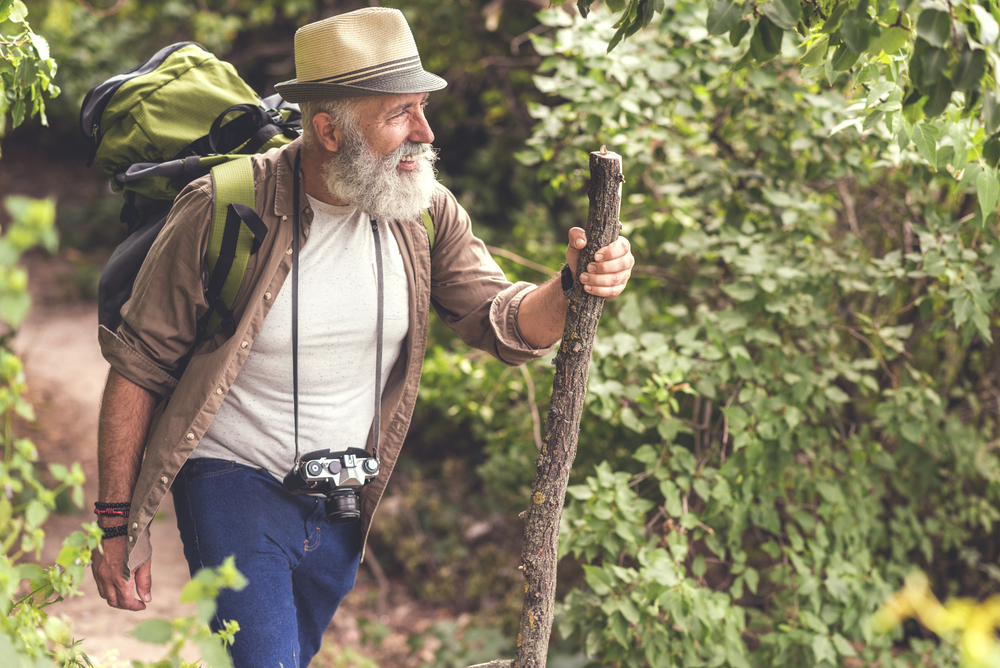If there’s one concern I have about my own personal survival, it’s whether or not I’ve got the physical strength and stamina to do what I’ll need to do, in order to survive. Actually, it’s not so much the strength that I’m concerned about; it’s the stamina. I have enough strength for most things; maintained by the amount of work I do around the house. But the stamina is another thing. I’m no spring chicken anymore and that shows up in my lack of stamina, more than in any lack of strength. Granted, I have to take the blame for this myself. I’ve never been one for exercise, or even playing sports. The word “exercise” for me means taking out the trash. Back when I was young, I survived a ten-mile-hike in boot came; carrying the typical soldier’s backpack. But that was many, many moons ago. If I were to try that today, they’d better have an ambulance following me.
Granted, I have to take the blame for this myself. I’ve never been one for exercise, or even playing sports. The word “exercise” for me means taking out the trash. Back when I was young, I survived a ten-mile-hike in boot came; carrying the typical soldier’s backpack. But that was many, many moons ago. If I were to try that today, they’d better have an ambulance following me.
Sadly, I’m not alone in this plight. I’ve met many a prepper who couldn’t bug out on foot if their lives depended on it. To make matters worse, the bug out bags they’ve prepared are so heavy, that it would take a football lineman to carry them further than to the next corner. They either have very optimistic plans about bugging out in their vehicles or just don’t expect to ever have to bug out at all.
Strength Vs. Stamina
To start off with, we need to have a good understanding of the difference between strength and stamina, as the two are often confused. Exercise gurus and personal trainers focus on strength, which is generally measured by how much weight you can lift or otherwise move in a variety of ways. Someone who can bench press 300 pounds has a lot of strength… at least in that particular exercise. But that isn’t everything. Just because they have a lot of strength for bench pressing or even for a dead lift, doesn’t mean that particular measurement of strength will apply to anything we need to do for survival.
Actually, weight training, whether done on machines or with free weights, has very little to do with practical strength. Those who practice this form of exercise are like anything else done for show. They look impressive on stage; but they can’t put those muscles to use in more practical ways. Rather than having practical strength, they often become muscle-bound, making it difficult for them to move in any but certain specific ways. In other words, while it might look like they could just tear logs apart for firewood, like Captain America, they probably can’t even split those logs with a maul.
One can have incredible strength, without having anything in the way of stamina. Likewise, one can have great stamina, without having much in the way of strength. The two use muscles differently, so increasing one usually doesn’t have any impact on the other.
So, what’s stamina then? Stamina can best be described by how long one can do a particular physical activity. On the simplest level, it’s how far you can walk, before you get exhausted. Those ten-mile hikes in basic training were all about stamina. Could we make it that far? For some of us, myself included, that required a greater physical exertion than we’d ever before attempted.
In reality, we need a combination of both strength and stamina to bug out. We’re going to have to be able to walk a long way in one day; but we’re going to have to carry our bug-out-bags while we’re doing it. The long walk will require stamina, while the added weight of the overloaded bug-out-bag will require strength.
Test Yourself
The old saying of “practice makes perfect” definitely applies to prepping. We should make a regular practice of doing everything we’re going to need to do in a survival situation. That might actually mean doing things that wouldn’t apply in one survival scenario, simply because they would apply in another. Some things are more universal, like cutting firewood. But scavenging for edible plants might not be used in every survival situation.
One of the many things we should practice is bugging out. Actually, we should practice both bugging out in our bug out vehicle and bugging out on foot, as the two are distinctly different. We might end up using the two together, starting out in our vehicle and only restoring to going on foot when fuel runs out; but those two parts of the bug out are different enough to seem as separate things.
So, the question we all face is just how far can we go, on foot, carrying our bug-out-bags? This is where I know I fall short, especially in the heat of where I live. I could probably do better in a cooler climate; but I’m not sure I could do well enough even then.
There’s a very real purpose in testing ourselves. That is, we need to have a baseline to use in our efforts to improve. If we don’t have that baseline to start with; then there’s no way we’re going to be able to measure just how much better we’re doing. So, when you do your test, make sure that you make it as realistic as possible, taking pains to measure both the distance you go and the time it takes to get there.
How “In Shape” Do You Need to Be?
The baseline is your starting point; but I’d say chances are pretty good that it’s not going to be your ending point. That has to be whatever you need it to be, so that you can put your survival plan into effect. Obviously, it will be different for some, than it is for others, just because of differences in people’s survival plans.
When you figure this out, make sure that you give yourself a safety buffer. In other words, if you will need to walk 10 miles per day, for five days, carrying 25 pounds, plan on walking 12 miles per day for six days, carrying 30 pounds. You don’t want to be working at your limit; hence the need for a buffer.
Develop a Physical Fitness Plan
Once you have that figured out, the question is how to get from one to the other. Obviously, that’s going to require pushing your body past what it’s used to, exercising it regularly. But just how much should you push it?
That depends a lot on you. Some people are fitness fanatics, who can push their bodies to the limit, gaining muscle mass and increasing their stamina at the same time. Others, like me, have to take it much slower. I could blame my age for that; but the truth is, I was never very good at exercise anyway. I doubt there was any time in my life, other than boot camp, where I can say that I really pushed my body.
Most people are better off with a longer-term plan, which allows them to build strength and stamina slowly, rather than pushing to do it quickly. That fast exercise plan may help you put on muscle mass; but it won’t help you keep it. you need something that will give you long-term strength and stamina, not just something to check off the box, then forget about it and let your body go to pot.
For most of us, this is going to take some sort of permanent lifestyle change. That could be something small, like walking every evening. Start off with what you can do now, then add to it bit by bit. Add distance one time, carrying a little weight another time, and speeding up how fast you walk still another time. Each addition is increasing your stamina, getting you to the point where you can carry that bug out bag for 12 miles a day.
The same sort of thing can be done for increasing your strength, if you need to. Rather than working on lifting weights, find something practical to do, like splitting firewood. If you’re not accustomed to doing that, I’m sure you’ll get tired fast the first time. But by splitting a log or two every day, you’ll gradually build your upper body strength in doing something useful, rather than in just lifting weights.
Make it a Lifestyle
Whatever you end up doing to increase your strength and stamina, it has to become a lifestyle change. It’s not enough that you just work to build up to a certain point, then quit. As soon as you quit, you’ll start losing the strength and stamina that you’ve gained, taking you back to where you were before. No, this has to be something permanent, which becomes part of your lifestyle.

Back when I was younger and had good stamina, my way of maintaining it was backpacking. We’d take weekend trips over some train in the Colorado Rockies, carrying a 25-to-30-pound pack. The combination of altitude thinned air, the steepness of the trial and the need to finish the trip by the end of the weekend, forced us to keep to a good speed. It soon became an enjoyable part of our life, seeing some beautiful country, while we kept our bodies in shape.
Read full article here


